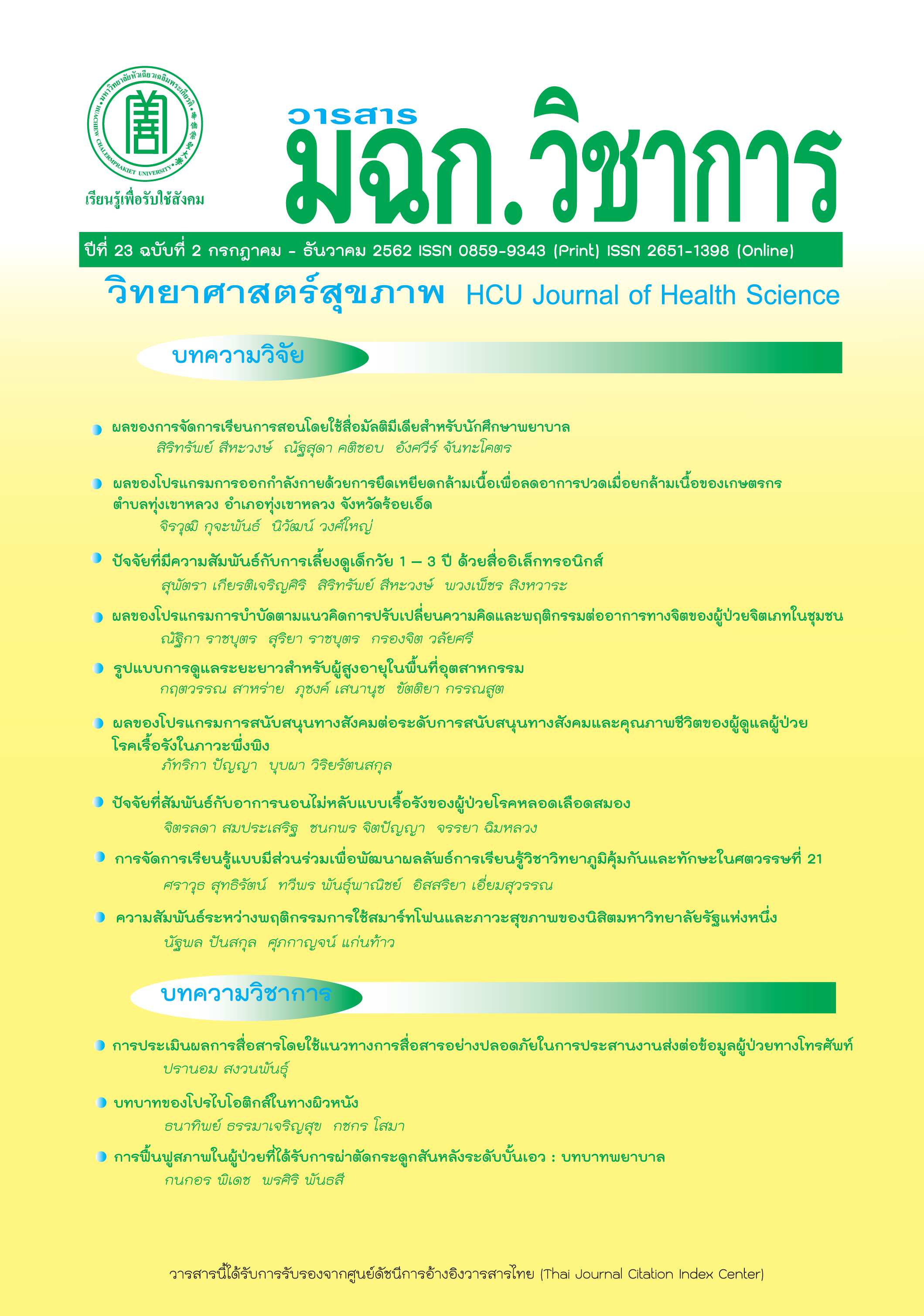Relationships between Smartphone Usage Behaviors and Health Conditions among Public University Students
Keywords:
smartphone usage behaviors, health status, university studentsAbstract
This cross-sectional analytical study aimed to investigate smartphone usage behaviors, health status, and factors associated with health status among public university students. The samples were 645 public university students, were selected by using multi-stage sampling procedures. The data were collected using a questionnaire consisted 3 parts. Part 1: demographic data. Part 2: smartphone usage behaviors assessment. And Part 3: health status assessment. The Cronbarch’s alpha coefficients were 0.785 and 0.876 respectively. The data were analyzed using descriptive statistics, Chi-square inferential statistics, and Spearman’s correlation coefficient at 99% confidence interval.
The results showed that university students were 18-20 years old. Duration of smartphone use was more 6 years (mean 6.13 years). Most used time period was 18.00-21.00. The mean amount of time spent using smartphone was 1 hour and 15 minutes. Smartphone usage behaviors were moderate to high levels. Affecting the health status at a moderate level. Factors; age, father's occupation, money received each month, and the type of internet were correlated with health status at statistically significant p-value < 0.001. Smartphone usage behaviors positively correlated with health status (r = 0.359, p-value < 0.001). Thus, the relevant agencies should be used in reducing smartphone addiction behavior formulation stimulation measures for prevent the impact on health status in the university student group.
Downloads
References
2. สิริกานต์ แก่นเพชร. การเสพติดสมาร์ทโฟนของนักศึกษาระดับอุดมศึกษาในจังหวัดเชียงใหม่. [การศึกษาค้นคว้าอิสระ]. เชียงใหม่: มหาวิทยาลัยแม่โจ้; 2559.
3. ปณชัย อารีเพิ่มพร. งานวิจัยเผยคนพกมือถือติดมือตลอดเวลาเพราะต้องตอบแชทคนรักช่วยเพิ่มความมั่นใจในสถานการณ์คับขัน [อินเทอร์เน็ต]. 2561 [เข้าถึงเมื่อ 20 กันยายน 2561]. เข้าถึงจาก: https://thestandard. co/global-mobile-consumer-survey/
4. เฉลิมพงษ์ จันทร์สุขา. พฤติกรมการใช้สมาร์ทโฟนกับสังคมก้มหน้า: กรณีศึกษา นักศึกษาระดับอุดมศึกษาในจังหวัดเชียงใหม่. [วิทยานิพนธ์]. เชียงใหม่: มหาวิทยาลัยแม่โจ้; 2559.
5. ชีวรัตน์ ปราสาร, สรัณยา เฮงพระพรหม, ณภัควรรต บัวทอง, ธนะภูมิ รัตนานุพงศ์. ความชุกของภาวะ nomophobia ในกลุ่มนิสิตนักศึกษาไทยระดับปริญญาตรีที่ใช้สมาร์ทโฟนในมหาวิทยาลัยภาครัฐ. Chula Med J. 2017;61(2):249-59.
6. จุฑามาศ กิติศรี, รัญชนา หน่อคำ, คนึงนิจ เพชรรัตน. พฤติกรรมการใช้สมาร์ทโฟนและการรับรู้ภาวะสุขภาพของนักศึกษาพยาบาล. วารสารการพัฒนาสุขภาพชุมชน. 2560;5(1):19–34.
7. เสฏฐวุฒิ แสนนาม. พฤติกรรมเสี่ยงอันตราย เรื่องง่ายๆ ที่ไม่ควรมองข้าม [อินเทอร์เน็ต]. 2558 [เข้าถึงเมื่อ 24 ตุลาคม 2561]. เข้าถึงจาก: https://www.thaicert.or.th/papers/general/2012/pa2012ge004.html
8. Moon JH, Kim KW, Moon NJ. Smartphone use is a risk factor for pediatric dry eye disease according to region and age: A case control study. BMC Ophthalmol. 2016;16(1):188.
9. Lee S, Kang H, Shin G. Head flexion angle while using a smartphone. Ergonomics. 2015;58(2): 220-6.
10. Lemola S, Perkinson-Gloor N, Brand S, Dewald-Kaufmann JF, Grob A. Adolescents’ electronic media use at night, sleep disturbance, and depressive symptoms in the smartphone age. J Youth Adolesc. 2015;44(2):405-18.
11. ภัทริยา อินทร์โท่โล่. การเปรียบเทียบอาการปวดกล้ามเนื้อขณะใช้งานสมาร์ทโฟนระหว่าง 3 กลุ่มอายุ: เด็กนักเรียนประถม นักเรียนมัธยม และผู้ทำงานสำนักงาน. วารสารวิจัยระบบสาธารณสุข. 2561;12(2):328-41.
12. วาสนา ศิลางาม. อันตรายของการเสพติดสมาร์ทโฟน. วารสาร มฉก วิชาการ. 2561;22(43-44):193-201.
13. อรุณี สรรสิริทรัพย์, วุฒิพงษ์ ชินศรี. การวิเคราะห์และประเมินความเสี่ยงในการใช้งานสมาร์ทโฟนของเจ้าหน้าที่กรมศุลกากร เฉพาะส่วนกลาง. วารสารวิจัยและพัฒนาวไลยอลงกรณ์ในพระบรมราชูปถัมภ์. 2559; 11:1.
14. Namwongsa S, Puntumetakul R, Swangnetr M. Prevalence and associated factor of musculoskeletal disorders among smartphone users. Work Preprint. 2018:1-12.
15. Joseph LF, Bruce L, Myunghee CP. Statistical methods for rates and proportions, 3rd ed. New Jersey: John Wiley & Son; 2003.
16. Demirci K, Akgönül M, Akpinar A. Relationship of smartphone use severity with sleep quality, depression, and anxiety in university students. J Behav Addict. 2015;4(2):85-92.
17. นาฎลดา เรืองชาญ, จินตนา จันทนนท์, ชนัญกาญจน์ แสงประสาน. การใช้สมาร์ทโฟนเพื่อการศึกษาของนักศึกษา คณะวิทยาการจัดการ มหาวิทยาลัยราชภัฏสกลนคร. วารสารวิชาการ สถาบันเทคโนโลยีแห่งสุวรรณภูมิ. 2561;4(2):294-303.
18. Haug S, Castro RP, Kwon M, Filler A, Kowatsch T, Schaub, MP. Smartphone use and smartphone addiction among young people in Switzerland. J Behav Addict. 2015;4(4):299-307.
19. Aljomaa SS, Qudah MFA, Albursan IS, Bakhiet SF, Abduljabbar AS. Smartphone addiction among university students in the light of some variables. Comput Hum Behav. 2016;61:155-64.
20. Kim HJ, Kim JS. The relationship between smartphone use and subjective musculoskeletal symptoms and university students. J Phys Ther Sci. 2015;27(3):575-9.
21. Pearson C, Hussain Z. Smartphone use, addiction, narcissism, and personality: A mixed methods investigation. IJCBPL. 2015;5(1):17-32.
22. Alosaimi FD, Alyahya H, Alshahwan H, Al-Mahyijari N, Shaik SA. Smartphone addiction among university students in Riyadh, Saudi Arabia. Saudi Medical J. 2016;37(6):675-83.
23. พลเทพ วิจิตรคุณากร, ชิดชนก มาทมาร, ณะนิดา ติรเศรษฐ์, ปกรณ์ อรุณสวัสดิ์, ปรินทร์ บุญธรรม, พฤฒิ คูนลินทิพย์. การใช้ Smartphone และ Tablet ในนักศึกษาแพทย์มหาวิทยาลัยสงขลานครินทร์. ธรรมศาสตร์เวชสาร. 2559;16:634-41.
24. Alfawareh HM, Jusoh S. Smartphone usage among university students: Najran university case. Int J Acad Res. 2014;6(2):321-6.
25. จิราภรณ์ ตั้งกิตติภาภรณ์. จิตวิทยาบุคลิกภาพและพฤติกรรมสุขภาพ. กรุงเทพมหานคร: โรงพิมพ์แห่งจุฬาลงกรณ์มหาวิทยาลัย; 2559.
26. Zulkefly SN, Baharudin R. Mobile phone use amongst students in a university in Malaysia: its correlates and relationship to psychological health. Eur J Sci Res. 2009;37(2):206-18.
Downloads
Published
How to Cite
Issue
Section
License
บทความที่ได้รับการตีพิมพ์เป็นลิขสิทธิ์ของวารสารวิทยาศาสตร์สุขภาพและสุขภาวะ
ข้อความที่ปรากฏในบทความแต่ละเรื่องในวารสารวิชาการเล่มนี้เป็นความคิดเห็นส่วนตัวของผู้เขียนแต่ละท่านไม่เกี่ยวข้องกับมหาวิทยาลัยหัวเฉียวเฉลิมพระเกียรติ และคณาจารย์ท่านอื่นๆในมหาวิทยาลัยฯ แต่อย่างใด ความรับผิดชอบองค์ประกอบทั้งหมดของบทความแต่ละเรื่องเป็นของผู้เขียนแต่ละท่าน หากมีความผิดพลาดใดๆ ผู้เขียนแต่ละท่านจะรับผิดชอบบทความของตนเองแต่ผู้เดียว




